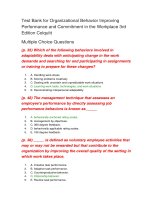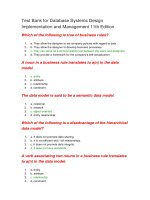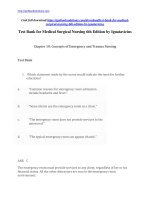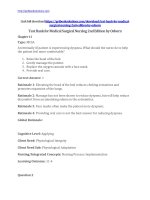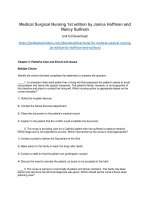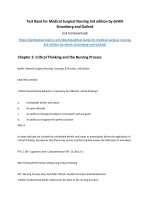Test bank for medical surgical nursing assessment and management of clinical problems 10th edition by lewis download
Bạn đang xem bản rút gọn của tài liệu. Xem và tải ngay bản đầy đủ của tài liệu tại đây (163.52 KB, 12 trang )
Test Bank For Medical-Surgical
Nursing Assessment and
Management of Clinical
Problems 10th edition by Lewis
Chapter 02: Health Disparities and Culturally Competent Care
MULTIPLE CHOICE
1. The nurse is obtaining a health history from a new patient. Which data
will be the focus of patient teaching?
a. Age and gender
c. Hispanic/Latino ethnicity
b. Saturated fat intake
d. Family history of
diabetes
ANS: B
Behaviors are strongly linked to many health care problems. The patient’s
saturated fat intake is a behavior that the patient can change. The other information
will be useful as the nurse develops an individualized plan for improving the
patient’s health, but will not be the focus of patient teaching.
DIF:
Cognitive Level: Apply (application)
TOP: Nursing Process:
Planning Maintenance
REF: 18
MSC: NCLEX: Health Promotion and
2. The nurse works in a clinic located in a community with many
Hispanics. Which strategy, if implemented by the nurse, would
decrease health care disparities for the Hispanic patients?
a. Improve public transportation to the clinic.
b. Update equipment and supplies at the clinic.
c. Obtain low-cost medications for clinic patients.
d. Teach clinic staff about Hispanic health beliefs.
ANS: D
Health care disparities are caused by stereotyping, biases, and prejudice of
health care providers. The nurse can decrease these through staff education. The
other strategies may also be addressed by the nurse but will not directly impact
health disparities.
DIF: Cognitive Level: Apply (application)
TOP: Nursing Process: Planning
Maintenance
REF: 19
MSC: NCLEX: Health Promotion and
3. What information should the nurse collect when assessing the
health status of a community?
a. Air pollution levels
Number of health food
b. stores
c. Most common causes of
death
Education level of the
d. individuals
ANS: C
Health status measures of a community include birth and death rates, life
expectancy, access to care, and morbidity and mortality rates related to disease and
injury. Although air pollution, access to health food stores, and education level are
factors that affect a community’s health status, they are not health measures.
DIF: Cognitive Level: Understand (comprehension)
TOP: Nursing Process: Assessment
Maintenance
REF: 18
MSC: NCLEX: Health Promotion and
4. The nurse is caring for a Native American patient who has traditional beliefs
about health and illness. Which action by nurse is most appropriate?
a.
Avoid asking questions unless the patient initiates the conversation.
b. Ask the patient whether it is important that cultural
healers are contacted.
c.
Explain the usual hospital routines for meal times, care, and family
visits.
d.
Obtain further information about the patient’s cultural
beliefs from a family member.
ANS: B
Because the patient has traditional health care beliefs, it is appropriate for the nurse
to ask whether the patient would like a visit by a shaman or other cultural healer.
There is no cultural reason for the nurse to avoid asking the patient questions because
these questions are necessary to obtain health information. The patient (rather than
the family) should be consulted about personal cultural beliefs. The hospital routines
for meals, care, and visits should be adapted to the patient’s preferences rather than
expecting the patient to adapt to the hospital schedule
DIF: Cognitive Level: Apply (application)
REF: 24
TOP: Nursing Process: Implementation MSC: NCLEX: Psychosocial Integrity
5. The nurse is caring for an Asian patient who is being admitted to the
hospital. Which action would be most appropriate for the nurse to take
when interviewing this patient?
a. Avoid eye contact with the patient.
b. Observe the patient’s use of eye contact.
c. Look directly at the patient when interacting.
d. Ask a family member about the patient’s cultural
beliefs.
ANS: B
Observation of the patient’s use of eye contact will be most useful in determining
the best way to communicate effectively with the patient. Looking directly at the
patient or avoiding eye contact may be appropriate, depending on the patient’s
individual cultural beliefs. The nurse should assess the patient, rather than
asking family members about the patient’s beliefs.
DIF: Cognitive Level: Apply (application)
TOP: Nursing Process: Implementation
Integrity
REF: 25
MSC: NCLEX: Psychosocial
6. A female staff nurse is assessing a male patient of Arab descent who is
admitted with complaints of severe headaches. It is most important for
the charge nurse to intervene if the nurse takes which action?
a. The nurse explains the 0 to 10 intensity pain scale.
b. The nurse asks the patient when the headaches
started.
c.
The nurse sits down at the bedside and closes the privacy
curtain.
d.
The nurse calls for a male nurse to bring a hospital gown to the
room.
ANS: C
Many men of Arab ethnicity do not believe it is appropriate to be alone with any
female except for their spouse. The other actions are appropriate.
DIF: Cognitive Level: Apply (application)
REF: 25
TOP: Nursing Process: Implementation MSC: NCLEX: Psychosocial Integrity
7. The nurse is caring for a patient who speaks a different language. If an
interpreter is not available, which action by the nurse is most appropriate?
a. Talk slowly so that each word is clearly heard.
b. Speak loudly in close proximity to the patient’s ears.
c. Repeat important words so that the patient recognizes their
significance.
d. Use simple gestures to demonstrate meaning while
talking to the patient.
ANS: D
The use of gestures will enable some information to be communicated to the
patient. The other actions will not improve communication with the patient.
DIF: Cognitive Level: Understand (comprehension)
REF: 31
TOP: Nursing Process: Implementation MSC: NCLEX: Psychosocial Integrity
8. The nurse plans care for a hospitalized patient who uses
culturally based treatments. Which action by the nurse is best?
a. Encourage the use of diagnostic procedures.
b. Coordinate the use of folk treatments with ordered
medical therapies.
c.
Ask the patient to discontinue the cultural treatments during
hospitalization.
d.
Teach the patient that folk remedies will interfere with orders by the
health care provider.
ANS: B
Many culturally based therapies can be accommodated along with the use of
Western treatments and medications. The nurse should attempt to use both
traditional folk treatments and the ordered Western therapies as much as possible.
Some culturally based treatments can be effective in treating “Western” diseases.
Not all folk remedies interfere with Western therapies. It may be appropriate for
the patient to continue some culturally based treatments while he or she is
hospitalized.
DIF: Cognitive Level: Apply (application)
TOP: Nursing Process: Planning
REF: 22
MSC: NCLEX: Psychosocial Integrity
9. The nurse is caring for a newly admitted patient. Which intervention
is the best example of a culturally appropriate nursing intervention?
a.
Insist family members provide most of the patient’s personal care.
b. Maintain a personal space of at least 2 feet when
assessing the patient.
c.
Ask permission before touching a patient during the physical
assessment.
d.
Consider the patient’s ethnicity as the most important factor in planning care.
ANS: C
Many cultures consider it disrespectful to touch a patient without asking
permission, so asking a patient for permission is always culturally appropriate.
The other actions may be appropriate for some patients but are not appropriate
across all cultural groups or for all individual patients. Ethnicity may not be the
most important factor in planning care, especially if the patient has urgent
physiologic problems.
DIF: Cognitive Level: Understand (comprehension)
REF: 28
TOP: Nursing Process: Implementation MSC: NCLEX: Psychosocial Integrity
10. A staff nurse expresses frustration that a Native American patient
always has several family members at the bedside. Which action by the
charge nurse is most appropriate?
a.
Remind the nurse that family support is important to this family and
patient.
b.
Have the nurse explain to the family that too many visitors will
tire the patient.
c.
Suggest that the nurse ask family members to leave the room during
patient care.
d.
Ask about the nurse’s personal beliefs about family support during
hospitalization.
ANS: D
The first step in providing culturally competent care is to understand one’s own
beliefs and values related to health and health care. Asking the nurse about
personal beliefs will help achieve this step. Reminding the nurse that this cultural
practice is important to the family and patient will not decrease the nurse’s
frustration. The remaining responses (suggest that the nurse ask family members to
leave the room and have the nurse explain to family that too many visitors will tire
the patient) are not culturally appropriate for this patient.
DIF: Cognitive Level: Apply (application)
REF: 23
TOP: Nursing Process: Implementation MSC: NCLEX: Psychosocial Integrity
11. An older Asian American patient tells the nurse that she has lived in
the United States for 50 years. The patient speaks English and lives in
a predominantly Asian neighborhood. Which action by the nurse is
most appropriate?
a. Include a shaman when planning the patient’s care.
b. Avoid direct eye contact with the patient during care.
c. Ask the patient about any special cultural beliefs or
practices.
d. Involve the patient’s oldest son to assist with health care
decisions.
ANS: C
Further assessment of the patient’s health care preferences is needed before
making further plans for culturally appropriate care. The other responses indicate
stereotyping of the patient based on ethnicity and would not be appropriate
initial actions.
DIF:
Cognitive Level: Apply (application)
TOP: Nursing Process: Planning
REF: 23
MSC: NCLEX: Psychosocial Integrity
12. The nurse plans health care for a community with a large number of recent
immigrants from Vietnam. Which intervention is the most important for the
nurse to implement?
a. Hepatitis testing
b. Tuberculosis screening
c. Contraceptive teaching
d. Colonoscopy information
ANS: B
Tuberculosis (TB) is endemic in many parts of Asia, and the incidence of TB is
much higher in immigrants from Vietnam than in the general U.S. population.
Teaching about contraceptive use, colonoscopy, and testing for hepatitis may also
be appropriate for some patients but is not generally indicated for all members of
this community.
DIF:
REF: 28
Cognitive Level: Apply (application)
TOP: Nursing Process: Planning
MSC: NCLEX: Physiological Integrity
13. When doing an admission assessment for a patient, the nurse notices
that the patient pauses before answering questions about the health
history. Which action by the nurse is most appropriate?
a. Interview a family member instead.
b. Wait for the patient to answer the questions.
c. Remindcare. the patient that you have other patients who need
d. Give the patient an assessment form listing the
questions and a pen.
ANS: B
Patients from some cultures take time to consider a question carefully before
answering. The nurse will show respect for the patient and help develop a
trusting relationship by allowing the patient time to give a thoughtful answer.
Asking the patient why the answers are taking so much time, stopping the
assessment, and handing the patient a form indicate that the nurse does not have
time for the patient.
DIF:
Cognitive Level: Apply (application)
TOP: Nursing Process: Assessment
REF: 30
MSC: NCLEX: Psychosocial Integrity
14. Which strategy should be a priority when the nurse is planning care
for a diabetic patient who is uninsured?
a. Obtain less expensive medications.
b. Follow evidence-based practice guidelines.
c. Assist with dietary changes as the first action.
d. Teach about the impact of exercise on diabetes.
ANS: B
The use of standardized evidence-based guidelines will reduce the incidence of
health care disparities among various socioeconomic groups. The other strategies
may also be appropriate, but the priority concern should be that the patient
receives care that meets the accepted standard.
DIF:
REF: 28
Cognitive Level: Apply (application)
OBJ: Special Questions: Prioritization
TOP: Nursing Process: Planning
MSC: NCLEX: Health Promotion and Maintenance
15. A Hispanic patient complains of abdominal cramping caused
by empacho. Which action should the nurse take first?
a. Ask the patient what treatments are likely to help.
b. Massage the patient’s abdomen until the pain is gone.
c. Administer cramping prescribed medications to decrease the
to contact a curandero(a) to make a visit to the
d. Offer
patient.
ANS: A
Further assessment of the patient’s cultural beliefs is appropriate before
implementing any interventions for a culture-bound syndrome such as empacho.
Although medication, a visit by a curandero(a), or massage may be helpful, more
information about the patient’s beliefs is needed to determine which
intervention(s) will be most helpful.
DIF:
REF: 29
Cognitive Level: Apply (application)
OBJ: Special Questions: Prioritization
TOP: Nursing Process: Assessment
MSC: NCLEX: Psychosocial Integrity
16. The nurse performs a cultural assessment with a patient from a
different culture. Which action by the nurse should be taken first?
a. Request patient an interpreter before interviewing the
b. Wait until a family member is available to help
with the assessment.
c. Ask the patient about any affiliation with a
particular cultural group.
d. Tell the patient what the nurse already
knows about the patient’s culture.
ANS: C
An early step in performing a cultural assessment is to determine whether
the patient feels an affiliation with any cultural group. The other actions
may be appropriate if the patient does identify with a particular culture.
DIF:
Cognitive Level: Apply (application)
OBJ: Special Questions: Prioritization
REF: 30
TOP: Nursing Process: Assessment
MSC: NCLEX: Psychosocial Integrity
17. The nurse working in a clinic in a primarily African American community
notes a higher incidence of uncontrolled hypertension in the patients. To
correct this health disparity, which action should the nurse take first?
a regular home-visit program by nurses
a. Initiate
working at the clinic.
b. Schedule teaching sessions about low-salt
diets at community events.
the perceptions of community members about the care at the
c. Assess
clinic.
low-cost antihypertensive drugs using funding
d. Obtain
from government grants.
ANS: C
Before other actions are taken, additional assessment data are needed to
determine the reason for the disparity. The other actions also may be appropriate,
but additional assessment is needed before the next action is selected.
DIF:
REF: 29
Cognitive Level: Apply (application)
OBJ: Special Questions: Prioritization
TOP: Nursing Process: Assessment
MSC: NCLEX: Health Promotion and Maintenance
MULTIPLE RESPONSE
1. The nurse is performing an admission assessment for a non–Englishspeaking patient who is from China. Which actions could the nurse take
to enhance communication (select all that apply)?
a. Use an electronic translation application.
b. Use a telephone-based medical interpreter.
c. Wait until an agency interpreter is available.
d. Ask the patient’s teenage daughter to interpret.
e. Use exaggerated gestures to convey information.
ANS: A, B, C
Electronic translation applications, telephone-based interpreters, and agency
interpreters are all appropriate to use to communicate with non–English-speaking
patients. When no interpreter is available, family members may be considered, but
some information that will be needed in an admission assessment may be
misunderstood or not shared if a child is used as the interpreter. Gestures are
appropriate to use, but exaggeration of the gestures is not needed.
DIF: Cognitive Level: Apply (application)
REF: 31
